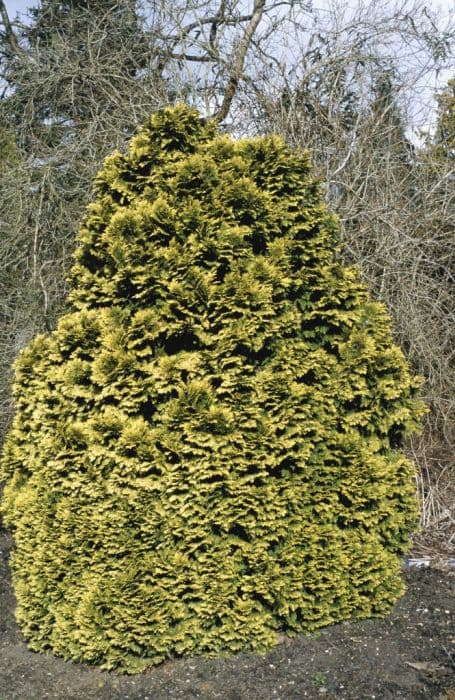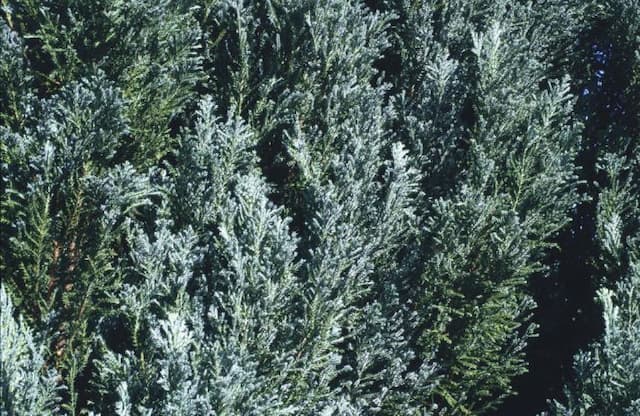Japanese cedar 'Sekkan-sugi' Cryptomeria japonica 'Sekkan-sugi'

ABOUT
'Sekkan-sugi' is a small, conical evergreen tree, to 10m tall, with semi-pendulous branches. The soft, awl-shaped leaves are a pale creamy-yellow colour when young, maturing to a dark green with yellow tints in winter
About this plant
 Names
NamesSynonyms
Japanese Cedar, Sekkan Sugi Cryptomeria, Sekkan-sugi Japanese Cedar, Yellow-tipped Japanese Cedar.
Common names
Cupressus japonica, Taxodium japonicum, Thuja japonica, Cryptomeria mairei, Schubertia japonica, Schubertia mairei, Sugi mairei.
 Characteristics
CharacteristicsLife cycle
Perennials
Foliage type
Evergreen
Color of leaves
Yellow-green
Height
15-20 feet (4.5-6 meters)
Spread
6-10 feet (1.8-3 meters)
Plant type
Tree
Hardiness zones
5
Native area
Japan
Benefits
 General Benefits
General Benefits- Aesthetic Appeal: Cryptomeria japonica 'Sekkan-sugi', commonly known as Japanese cedar, has a unique and striking appearance with its bright yellow foliage and attractive structure, enhancing garden aesthetics.
- Landscape Design Versatility: It can be used for a variety of landscape designs, including specimen planting, hedges, or screen plantings, because of its flexible growth habit.
- Drought Tolerance: Once established, Japanese cedar can withstand periods of dry conditions, making it suitable for xeriscaping or drought-prone areas.
- Wildlife Support: The plant can provide shelter and nesting sites for birds and other wildlife, enriching local biodiversity.
- Low Maintenance: It requires minimal pruning and care once established, making it a practical choice for busy gardeners.
- Seasonal Interest: Japanese cedar offers year-round interest thanks to its evergreen nature, providing a constant splash of color even in the colder months.
- Privacy: When used as hedging or screening, Japanese cedar can create a dense, living privacy screen due to its foliage and growth habit.
 Medical Properties
Medical PropertiesThis plant is not used for medical purposes.
 Air-purifying Qualities
Air-purifying QualitiesThis plant is not specifically known for air purifying qualities.
 Other Uses
Other Uses- Cryptomeria, or Japanese cedar, wood shavings and chips are often used in gardening as a natural mulch to retain soil moisture and deter weeds.
- The aromatic wood of the Japanese cedar is used in the production of traditional Japanese incense, contributing a woody, calming fragrance.
- Fine grain of Japanese cedar wood makes it an excellent material for making wooden ornaments and small intricate carvings.
- Japanese cedars are used as windbreaks and privacy hedges due to their dense foliage and fast-growing nature.
- The lightweight yet strong timber is used in the construction of traditional Japanese tea houses and Shinto shrines.
- In Japan, the wood is utilized to construct "sugi-ban," or Japanese cedar barrels, which are traditionally used for storing sake.
- The wood, resistant to rot and decay, makes for durable outdoor construction materials, such as decking and fencing.
- Due to its acoustic properties, Japanese cedar wood is sometimes used in making musical instruments such as drum shells.
- In forestry, the tree is planted for soil erosion control as its roots hold the soil effectively, particularly on hillsides.
- The softwood is occasionally used for making lightweight saunas because it can withstand humidity and high temperatures.
Interesting Facts
 Feng Shui
Feng ShuiThe Japanese Cedar is not used in Feng Shui practice.
 Zodiac Sign Compitability
Zodiac Sign CompitabilityThe Japanese Cedar is not used in astrology practice.
 Plant Symbolism
Plant Symbolism- Longevity: The Japanese cedar is known for its long lifespan, often symbolizing eternal life and endurance through the ages.
- Strength: Due to its tall and sturdy nature, the Japanese cedar represents strength and resilience, capable of withstanding various environmental challenges.
- Sacredness: In Japan, the tree is often found near temples and shrines, signifying its role as a sacred tree that connects the physical world to the spiritual realm.
- Peace: The evergreen qualities of the Japanese cedar convey a sense of peace and tranquility, which is why it’s often planted in serene settings such as gardens and parks.
- Rejuvenation: With 'Sekkan-sugi' particularly known for its bright, creamy-yellow foliage, it brings with it a symbol of renewal and rejuvenation, a fresh start or a new beginning.
 Water
WaterThe Japanese Cedar requires consistent moisture, especially during dry periods, to prevent the soil from drying out completely. It's best to water deeply once a week, providing about 1.5 gallons of water for smaller plants and up to 2.5 gallons for larger established trees. Adjust frequency to account for rainfall, with less water needed during wet seasons and more in drought-like conditions. Ensure that the soil drains well to prevent root rot, and always check the top inch of soil for dryness before watering.
 Light
LightThe Japanese Cedar thrives in full sun to partial shade conditions. Ideal planting spots are those that receive several hours of direct sunlight daily but are protected from the harshest midday sun, which can sometimes cause foliage burn. The tree will perform best with a minimum of four hours of unfiltered sunlight, favoring the morning and late afternoon light.
 Temperature
TemperatureThe Japanese Cedar is a hardy plant, capable of withstanding temperatures as low as -20 degrees Fahrenheit and as high as 90 degrees Fahrenheit, though the ideal temperature range is between 60 and 70 degrees Fahrenheit. It's important to protect the tree from strong winds, which can cause drying and browning of the foliage in colder temperatures.
 Pruning
PruningPruning the Japanese Cedar should be done to maintain shape and remove any damaged or diseased branches, encouraging a strong tree structure. The best time to prune is in the late winter or early spring before new growth starts. It's generally not necessary to prune every year; every 2-3 years or as needed should maintain its aesthetic appeal and health.
 Cleaning
CleaningAs needed
 Soil
SoilThe best soil mix for Japanese Cedar is well-draining soil with good organic matter content. Aim for a soil pH between 5.0 and 7.0 to ensure proper growth.
 Repotting
RepottingJapanese Cedar should be repotted every 2 to 3 years, or when it becomes root-bound and the growth starts to slow down.
 Humidity & Misting
Humidity & MistingJapanese Cedar thrives best in moderately high humidity levels, however, it is adaptable and can tolerate lower humidity conditions.
 Suitable locations
Suitable locationsIndoor
Ensure bright light, good airflow, and room to grow.
Outdoor
Plant in well-drained soil, full sun to partial shade.
Hardiness zone
5-9 USDA
 Life cycle
Life cycleThe life of Cryptomeria japonica 'Sekkan-sugi', also known as Japanese Cedar, begins with germination, where seeds sprout in favorable conditions of moisture and temperature. The seedlings gradually develop into juvenile plants, displaying characteristic bright yellow to creamy-white new foliage that contrasts with the older, green leaves. As they enter the vegetative growth stage, they grow rapidly in height and girth, forming a conical shape with dense foliage. Upon reaching maturity, which may take several years, these evergreens start producing small, globular cones that contain the seeds for reproduction. The mature Japanese Cedar enters a long reproductive phase, where it can produce cones annually for many years. As it ages, growth slows, and the once dense foliage may thin, eventually leading to the plant's natural decline and the end of its life cycle.
 Propogation
PropogationPropogation time
Late Winter - Early Spring
The Japanese Cedar 'Sekkan-sugi' is commonly propagated through semi-hardwood cuttings. The best time for taking cuttings for propagation is typically during mid-summer to early fall. To propagate by cuttings, a healthy, semi-hardwood branch is selected and cut into sections that are 4 to 6 inches (about 10 to 15 cm) in length, making sure that each cutting has several sets of needles. The bottom end of the cutting is dipped in rooting hormone before being placed in a well-draining rooting medium, such as a mix of peat moss and perlite. The cuttings should be kept moist and in a warm location with indirect light until roots have developed, which can take several weeks to a few months. After rooting, the new plants can be hardened off and eventually planted in their permanent location.









